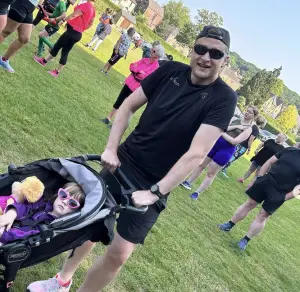To find a balance between getting your child away from the ever-present tablet and getting some much-needed exercise is not an easy task. In the end, as a parent, your child’s well-being is the most important thing in life, but just how far can you push them off the couch and into physical pursuits? And are there any risks involved that can stunt their growth?
Running does not stunt the growth in children; exercise promotes healthy growth. However, parents and coaches should avoid exposing children to permanent injuries due to overuse, overtraining, and burnout. Therefore, children should be monitored to determine possible adjustments in activities.
The time-worn phrase “less is more” is an apt rule to live by regarding physical activity in children. Of course, there is nothing wrong when children engage in physical pursuits, and it is beneficial for them, but there are times where exercise should take a backseat to allow for rest and recuperation.
Can Running Stunt a Child’s Growth?
Perhaps you wonder if a 26-mile marathon is safe for your thirteen-year-old child to participate in; the answer is probably no. Most marathons will prescribe for minimum age, generally between 16 and 18 years old. However, you might find the age requirement dropping along with the marathon’s distance, and there is a good reason for this. A developing child’s body is vulnerable to injuries, and as they grow, these susceptibilities slowly decrease as bones, joints, and muscles become stronger. If this process is compromised, there can be lasting damage.
Surprisingly, the issue has not been the subject of a great deal of scientific inquiry, and for parents concerned about their young runners, there isn’t a definitive answer. While orthopedic surgeons have warned parents about the dangers of too many baseball throws and soccer kicks, they have been less definitive about running.
The Atlantic
Unfortunately, at this point, there aren’t any adequate studies done to determine if there is any possible detrimental effect caused by running, and until the world of medicine knows more, it is best to err on the side of caution. Running, per se, won’t stunt growth, but it can cause lasting damage in cases where no precautions were taken or where a child is pushed to the extreme of their capabilities. Just because you can, doesn’t mean you should.
Jogging for a couple of miles should be perfectly fine for your child as long as there are no symptoms of any kind. Sure, getting tired and winded is normal, especially in the beginning stages. Still, as soon as you notice your child showing signs of extreme discomfort or pain, it might be a good time to slow down and assess the situation.
When is it too much?
The American Academy of Pediatrics’ official journal published an article outlining the various risks associated with disproportionate exercise and what type of injuries can be sustained during uncontrolled physical activity in developing children.
- Overuse injuries are defined as “…microtraumatic damage to a bone, muscle, or tendon that has been subjected to repetitive stress without sufficient time to heal or undergo the natural reparative process.” The Academy places emphasis on the need for proper rest periods. Overuse can result in pain during and after physical activity. Therefore, it is crucial to give young athletes time to recover to avoid lasting and irreparable damage.
- Overtraining is not easily put into parameters but can be avoided by keeping up physical activity while employing a system of varied activities. The Academy recommends pursuing less strenuous exercises for alternate days.
- Burnout (overtraining syndrome) has a direct link to overtraining, where sports performance declines as a result of a “series of psychological, physiologic, and hormonal changes that result in decreased sports performance.”
Well-rounded, multisport athletes have the highest potential to achieve the goal of lifelong fitness and enjoyment of physical activity while avoiding some of the pitfalls of overuse, overtraining, and burnout provided that they participate in moderation and are in tune with their bodies for signs of overuse or fatigue.
Pediatrics
Age and distance recommendations for running
The table below is a very rough guide because children do not develop at the same rate; in this instance, age appears to be just a number. The best way to have some peace of mind is to make an appointment with the Pediatrist and discussing the situation in more detail.
| Age | Recommendation |
| > 7 | 1 or 2 miles |
| 8 to 12 | 3 miles |
| 13 to 15 | 6 miles |
| 16 to 18 | 6+ miles |
Does Running Affect a Child’s Height?
Just as running doesn’t negatively bear on growth, it is unlikely to make a child shorter or even taller than their genetics will allow. Though it is not uncommon for a short child to born from tall parents, and vice versa, running won’t necessarily be a contributing factor.
Despite the small number of studies with adequate methodology, especially randomized clinical trials, evidence appears to indicate that physical exercise is safe for both the pregnant woman and the child, from fetal life to adolescence. Physical exercise does not appear to impair the child’s linear growth and contributes to the ideal shaping of bone and muscle tissues, ensuring possible beneficial effects throughout life.
ScienceDirect
What does science say about elements that affect height?
According to Medical News Today, a few factors affect height, such as DNA, hormones, and sex (the biological difference between males and females). There is no mention that any physical activity can negatively affect a person’s height while growing up. However, they do mention things you can do to ensure good growth and hopefully maximize adult height.
- Nutrition
Propper nutrition is vital, particularly protein and calcium that promote the healthy development of bones and muscles. Some protein examples are nuts and seeds, seafood, eggs, and poultry. Calcium-rich foods include milk, cheese, broccoli, salmon, and yogurt.
- Sleep
Seven to eight hours of sleep a night is enough for most adults, but children need a little more while they grow. The CDC (Centers for Disease Control and Prevention) recommends that children between the ages of 6 and 12 need between 9 and 12 hours of sleep, and teens needs between 8 and 10 hours of sleep. Access the full chart here.
- Exercise
As another critical element to good growth, regular proportionate exercise will support normal physical development. The only time when exercise can hurt your child is with overuse and overtraining. Of course, as with any physical pursuit, accidents can happen that can result in injuries as well.
Running would probably not be very healthy if there is a lack of proper nutrition and sufficient sleep. Our bodies require these elements to function at an optimal level. Removing it from the equation and only leaving exercise as the element for good growth is like placing a plant in the sun without adequate water. Both are essential, but too little of one and not enough of the other will surely be detrimental to healthy development.
Growth Problems and Contributing Causes
According to the Boston Children’s Hospital, growth problems occur in children due to hormonal disorders, illnesses affecting the entire body, poor food absorption, or just plain old genetics. They provide a long list of possible reasons, but running – or physical activity – is not included in this list. However, the list might also not be exhaustive, but it would have deserved even a mention if there were proof that running could curb healthy growth.
To read more about growth problems, read the full article here.
Can Working Out (Weight Lifting) Stunt Child Growth?
Resistance training (RT), in a controlled environment, has many benefits for kids. Of course, a six-year-old won’t be much interested in gaining some strength, but a teenager can safely partake in weightlifting as long as there is expert supervision or guidance. The goal here is not to become the next Jonny Bravo or a powerlifter but to improve strength and BSI (bone strength index).
Eight Tips for Running With Your Child
- Encourage
When your child starts showing interest in running, you should be supportive and encourage the whim. Sure, you can bring up the idea and see if it takes, but never push your children into it. If they lose interest, especially when your kids are pretty young, don’t feel disheartened, you never know what the future holds.
- Get the goods
Make sure your child has the right gear for running, especially the correct trainers. If you are a runner, you should know just how terrible running can be with the wrong shoes. It is also a good idea to get your kid a heart rate monitor to keep an eye on how they are doing during the run. If you notice that their heart rate is spiking too high or dipping too low, stop immediately as your child might not be feeling well.
- Make it fun
Fun might not be a requirement for teens, but for younger kids, running might become a little tedious after the initial novelty of it all faded. If this happens, you can make it a bit more exciting by signing up for fun runs. However, if you have to drag your child out of the house, kicking and screaming, running might just not be it for them.
- Give it time
If you are a first-time runner taking your kid along, it is the perfect time for both of you to start slow and build your way up. However, if you have been running for years, you must be prepared to bring it down a nudge or two. Your child might not be able to keep up with you, and that is perfectly normal. If you feel that running with your child is not enough exercise, you can always work in a good run at the gym or in the morning before work.
- Safety
Before you set out running, make sure your kid knows the routes as well as the way home if they need to make it back without you for some reason. In addition to location awareness, it might be a good idea to have a quick brush up on the necessary pedestrian rules. Finally, always take your cellphone along if you might need to call for help.
- Give it a rest
Rest days are crucial for the healthy development of children. If your kid is already doing other sports at school, running on top of it might result in overuse injuries. However, if running is all that’s on the menu, four or five days a week should be ok for running but allow at least two or three days of rest. Then, you can take your kid’s R&R days to pick up on the miles you lost.
- Nutrition
A bowl of Fruit Loops every morning might be fun and delicious but probably not very nutritious for active kids. Instead, ensure that they have a balanced diet by incorporating protein and calcium in their daily meals.
- Make a special time for bonding
It is no secret that between work and home and all the responsibilities that go along with them, we often find ourselves wishing for more time. If you feel that you need to spend more time with the kids but also need to run, you can incorporate the two and have the best of both.
Conclusion
Running, and therefore exercise in general, is safe for children and will not affect their growth or height. However, keep in mind that your child is still developing. Consequently, you should monitor all activities to ensure there is no risk of overuse, overtraining, or burnout, as these may result in irreparable damage.
Sources
https://pubmed.ncbi.nlm.nih.gov/14627869/
https://pediatrics.aappublications.org/content/119/6/1242.full
https://pubmed.ncbi.nlm.nih.gov/12119870/
https://www.healthline.com/health/does-lifting-weights-stunt-growth
https://www.ncbi.nlm.nih.gov/pmc/articles/PMC5532191/
https://www.medicalnewstoday.com/articles/327514
https://www.sciencedirect.com/science/article/pii/S002175571831026X#
https://pubmed.ncbi.nlm.nih.gov/8614759/
https://www.who.int/news/item/19-11-2015-stunting-in-a-nutshell
https://www.childrenshospital.org/conditions-and-treatments/conditions/g/growth-problems


